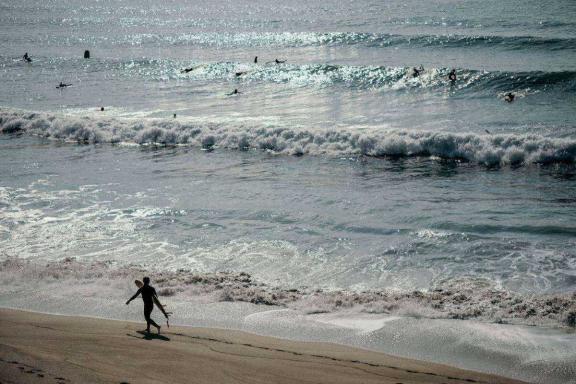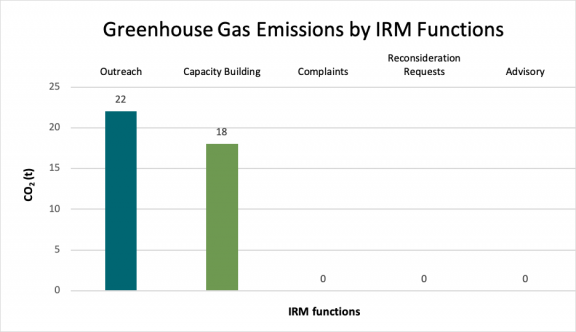The IRM’s Carbon Footprint – Challenges and Opportunities in Reducing Greenhouse Gas Emissions
In fulfilling their mandates, the staff members of international organisations have to travel on missions, including to participate in international meetings, conduct site visits, and engage in person with diverse stakeholders. The Independent Redress Mechanism (IRM) of the Green Climate Fund (GCF) shares similar travel needs. International travel has been considered integral to fulfilling the IRM’s mandate in addressing complaints from project-affected people about adverse social and environmental impacts from GCF projects and programmes. However, international travel also produces a carbon footprint. For the IRM of the foremost climate finance institution in the world committed to supporting developing countries with climate mitigation and adaptation projects and programmes, this poses a challenge.
The GCF is expected to continue approving projects/programmes and disbursing funds to numerous regions around the world. This foreseen increase in the number of projects and programmes signifies the greater likelihood of observing grievances in and receiving complaints from many corners of the globe. Thus, there will be a growing need for the IRM to fulfil its functions throughout the locations of the GCF’s portfolio. First, the IRM will be required to make more frequent site visits to handle complex cases. Second, the IRM will have to conduct outreach events in a broader span of regions to engage with stakeholders in the field. Lastly, with an increase in the number of Accredited Entities (AEs), the IRM also has to build the capacity of GCF’s Direct Access Entities (DAEs). Such widening of the IRM’s breadth of work will very likely mean the rise in the IRM’s need for more frequent international mission trips.
According to the Greening the Blue report 2019, which illustrates the environmental impacts of more than 60 United Nations entities and their efforts to reduce those impacts throughout 2018, 42 per cent of their total emissions derive from air travel. This amounts to almost 3 tonnes of CO2 equivalent per employee, which is only slightly less than the Intergovernmental Panel on Climate Change’s recommended per capita carbon footprint of 3.16 tonnes of CO2 equivalent[1] (including all other sources of emissions such as transport, energy and waste consumption) by 2050. Similarly, in the case of the GCF, air travel takes a significant portion of its administrative budget. Especially since the GCF is headquartered in the Korean Peninsula, air travel is the only option for trips outside of the country.

For the above reasons, the IRM decided to examine data of its carbon emissions from air travel to assess its environmental impact. The IRM recognizes that this initial effort is a limited view of its entire carbon footprint since many other sources, such as energy and food consumption, emissions from different types of transportation, waste disposal and wastewater treatment, are not taken into account. However, since air travel is essential to delivering the IRM’s mandates, the aims are to start establishing a baseline for its air travel carbon footprint and take mitigatory actions. A more accurate assessment that includes sources of carbon emissions will be done in the future. The IRM’s efforts are more than a mere exercise in assessing it’s carbon footprint; the IRM commits to reducing its emissions and offsetting the inevitable emissions at the most practical level. As such, in addition to handling complaints about the adverse impacts of GCF projects, the IRM aims to take a proactive role within the organisation in reducing its carbon and environmental footprint while accomplishing its work.
For the sake of transparency, the IRM calculated the carbon emissions from its history of air travel in 2019 which only involves the travels funded by the IRM to carry out its functions, to hire staff members and to support employee welfare. This includes official work-related travel of IRM staff, sponsorship for travel of workshop participants, recruitment of staff, staff training and development and staff or family home leave for IRM personnel (entitlements based on GCF policies). The data was generated on the basis of information obtained from the International Civil Aviation Organization (ICAO) and its carbon emissions calculator. This methodology takes into consideration multiple factors such as aircraft types, route-specific data, passenger load factors and cargo carried. The calculator retrieves sets of embedded data, such as the fuel burned according to the type of aircraft and the travel distance. By simply inserting the type of trip (one way/round trip and cabin class), the number of passengers and the city of departure, transit and arrival, it is possible to work out the total amount of carbon emissions for a specific journey.
Although carbon equivalent, by definition, includes all the other sources of greenhouse gases such as methane and nitrous oxide, after a considerable amount of research, the IRM decided not to include them in our calculation. For the most part, these emissions are immaterial and even if they do exist, there is still a significant controversy on how much of these other greenhouse gases are actually released from aircraft. Accordingly, the IRM’s total CO2 emissions for 2019 is approximately 61 tonnes.[2] Two-thirds of these emissions fall under two categories, ‘Work-Related Travel’ and ‘Workshop Participants’, and the final one-third falls into the category ‘Staff Recruitment and Benefits’ which includes ‘Staff Recruitment’, ‘Staff Leave’, ‘Family Leave’ and ‘Staff Development and Training’. The major events that required travelling in 2019 consisted of an outreach workshop in Chile where the IRM sponsored seven regional flights for Civil Society Organisations (CSOs) and a capacity building training at the GCF’s headquarters in Songdo, South Korea, which 14 participants from Grievance Redress Mechanisms of Direct Access Entities attended. Furthermore, IRM staff participated in other outreach events such as the Annual Meeting of the Independent Accountability Mechanisms Network (IAMnet) in Abidjan, the United Nations Forum on Human Rights in Geneva and workshops with CSOs in Thailand, Bangladesh, Chile and China as well as one training course in the United States.

The TOR of the IRM provides it with five functions: ‘complaints and grievances’, ‘reconsideration requests’, ‘outreach’, ‘capacity building’ and ‘advisory.’ The emissions from air travel in 2019 were mainly produced while fulfilling the outreach (around 22 tonnes) and capacity building (around 18 tonnes) mandate (a more detailed description of the events is presented above). In 2019, the IRMs cases or requests did not require field missions and therefore, no additional travel emissions were produced which fall under the other IRM functions. Even though staff recruitment, staff and family leave, and staff development/training are linked to serving the IRM’s goals, those figures were omitted from the following chart since those costs are spread across all of the IRM’s functions.

The IRM’s work and the ensuing travels were conducted with a justifiable purpose; however, it would not be responsible to justify its carbon emissions by simply asserting that they were inevitable. In fact, though initially not voluntary, Covid-19 has proven to the IRM that much of its work can be managed virtually. The IRM had planned for the first-ever Grievance Redress and Accountability Mechanism (GRAM) conference and an outreach event in South Africa this March and April. However, after all its efforts to modify the events to adjust to the evolving crisis, they eventually had to be cancelled due to the dreadful spread of Covid-19 pandemic. Nevertheless, believing itself as an early adapter, the IRM made a transition into a fully virtual team. The IRM consulted with external stakeholders and internally cooperated to redesign its capacity building and outreach events, and the first virtual outreach session was successfully hosted in June. In preparation for the capacity building event, to replace a few days of intensive training sessions that would otherwise be held in South Korea where the GCF is headquartered, the IRM prepared online learning modules to provide a similar, if not equal, quality of information and learning to the participants.
This new transition is still an ongoing process and the IRM is continuously learning from its experiences. The IRM has to consider the potential connectivity issues that the participants may face, restricting the ability of some of the stakeholders to join the training or outreach sessions. Moreover, not all of the IRM’s tasks can be managed virtually, especially the complaints-handling processes. For example, upon declaring C-0003-Morocco eligible, the IRM sought chances to visit the project site in Morocco to clarify the issues at stake and build trust with the parties involved. However, the IRM had no option but to conduct virtual meetings due to Covid-19, making it a challenging procedure for the IRM to pursue its initial consultations with the stakeholders.
After all its attempts to make the procedures virtual and carbon free, when such complications persist, the IRM will ultimately have to consider travelling. The IRM, however, does not intend to group such travels as ‘inevitable,’ but is committed to acting responsibly. It will do its utmost to offset such unavoidable emissions. Luckily, all the IRM staff members have expressed their willingness to offset their carbon footprints by making voluntary personal payments through one of the many payment options designed to offset greenhouse gas emissions produced by individuals or organisations. The United Nations, for example, offers offsetting through certified projects that reduce, avoid or remove greenhouse gas emissions from the atmosphere. The platform Climate Neutral Now is an initiative by the UN Framework Convention on Climate Change (UNFCCC). There are also other initiatives which offer carbon offsets such as atmosfair, a German based non-governmental organisation or terrapass, a social enterprise based in the United States. According to their different standards and calculation methods, the entire IRM team will need to make compensation payments between 600 and 1600 USD. However, although these voluntary efforts are already a milestone, offsetting needs to be gradually institutionalised into a broader policy. It is promising that the GCF has joined the Greening the Blue Initiative and adopted its first sustainability strategy in July 2020, which is a significant step in the right direction.
2020 is forecast to be a year with an exceptionally low carbon footprint due to Covid-19 and will not serve as a fair comparison to the base year of 2019. This is supported by a report[3] which claims that Covid-19 lockdown measures have resulted in “the sharpest decline in carbon output since records began,” with a daily global CO2 drop of 17 per cent in early April 2020 compared with 2019. In particular, emissions from aviation showed a 60 per cent decline. Hence, the IRM will instead make good use of this opportunity to start mainstreaming carbon emissions reductions into all its operations and meet its goal of a 25 per cent reduction in its carbon footprint by 2021 compared with 2019. Especially during these times where the IRM is constantly coming up with new ideas to adapt to the crisis and become more resilient, it will be extremely important that it puts in place the right measures that will be sustainable throughout the IRM’s future.
Article prepared by Paul Safar, Sue Kyung Hwang and Lalanath de Silva
[1] Total carbon emissions of 2010 and population estimates for 2050 are based on World Bank data.
[2] The GCF Secretariat is also calculating its total carbon emissions based on air travel. Although the Secretariat and the IRM use the same calculation methods, our approaches to the data (e.g. which sections are included) differ slightly.
[3] See Le Quéré et al.’s article “Temporary reduction in daily global CO2 emissions during the COVID-19 forced confinement” published in National Climate Change in 2020.